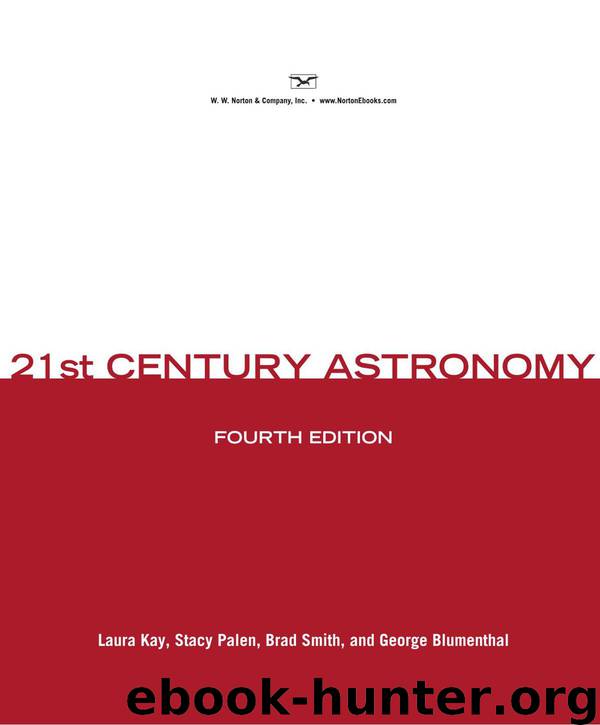21st Century Astronomy (Full Fourth Edition) by Laura Kay

Author:Laura Kay
Language: eng
Format: mobi
Published: 0101-01-01T00:00:00+00:00
5. The stars are in circular orbits. You know this because
G( m + m )
1
2
the Doppler velocities about the star are symmetric; the
Rearranging this equation a bit turns it into an expression for
approach and recession speeds of the star are equal.
the sum of the masses of the two objects:
These data are summarized in Figure 13.15. You begin
A 3
m + m = 4π2
____ ×
___
your analysis by noting that the star is an eclipsing binary,
1
2
G
P 2
which tells you that the orbit of the star is edge-on to your
We can ignore the value of 4π2/ G by applying what we know
line of sight. The Doppler velocities tell you the total orbital
about Earth’s orbit around the Sun, and then expressing m, A,
velocity of each star, and you determine the size of the orbits
and P as ratios. If A = 1 AU and P = 1 year, M = mass of the
£
using the relationship Distance = Speed × Time. In one or-
Sun and M = mass of the Earth, then we know that m + m =
¢
1
2
bital period, star 1 travels around a circle—a distance of
M + M ≈ M (because M is much larger than M ). So if we
£
¢
£
£
¢
express the masses m and m , A, and P in that equation in terms
d = (20.4 km/s) × (2.63 yr) = 53.7 km × yr/s
1
2
of Solar System units—such as m = m /(1 M ), A = A/(1 AU),
1
1
£
AU
and P
= P/(1 year)—then this equation simplifies to:
You multiply by the number of seconds in a year:
years
m
m
( A ) 3
km × yr
3.16 × 107 s
d = 53.7
Download
This site does not store any files on its server. We only index and link to content provided by other sites. Please contact the content providers to delete copyright contents if any and email us, we'll remove relevant links or contents immediately.
Whiskies Galore by Ian Buxton(41880)
Introduction to Aircraft Design (Cambridge Aerospace Series) by John P. Fielding(33064)
Rewire Your Anxious Brain by Catherine M. Pittman(18553)
Craft Beer for the Homebrewer by Michael Agnew(18141)
Cat's cradle by Kurt Vonnegut(15186)
Sapiens: A Brief History of Humankind by Yuval Noah Harari(14252)
Leonardo da Vinci by Walter Isaacson(13186)
The Tidewater Tales by John Barth(12608)
Thinking, Fast and Slow by Kahneman Daniel(12079)
Underground: A Human History of the Worlds Beneath Our Feet by Will Hunt(12024)
The Radium Girls by Kate Moore(11921)
The Art of Thinking Clearly by Rolf Dobelli(10224)
A Journey Through Charms and Defence Against the Dark Arts (Harry Potter: A Journey Throughâ¦) by Pottermore Publishing(9232)
Mindhunter: Inside the FBI's Elite Serial Crime Unit by John E. Douglas & Mark Olshaker(9203)
Tools of Titans by Timothy Ferriss(8218)
Wonder by R. J. Palacio(8010)
Turbulence by E. J. Noyes(7936)
Change Your Questions, Change Your Life by Marilee Adams(7635)
Nudge - Improving Decisions about Health, Wealth, and Happiness by Thaler Sunstein(7615)
